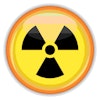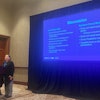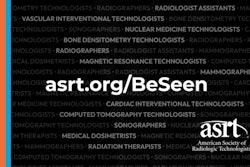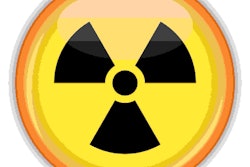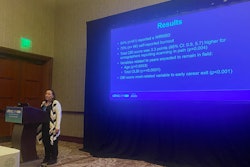As the American Society of Radiologic Technologists (ASRT) prepares to announce changes to its professional pathways and practice standards at its June meeting in Orlando, FL, ASRT Board President Brandon Smith said the state of the field is "more palpable than ever."
An ASRT video published in March began setting the stage for what is to come from the collective professional trust of 18 radiologic science organizations. Together, they form the Consensus Committee on the Future of Medical Imaging and Radiation Therapy. With industry guidance on professional-entry pathways coming soon, the Consensus Committee's findings will draw from two significant problems facing the workforce.
One is the personnel shortage for licensed, certified, and registered radiologic technologists (RTs). News stories spotlight only some of the obstacles to ensuring adequate RT staffing to meet the needs of hospitals and health systems in the U.S.
Illustrating the lengths healthcare organizations will go to for RT employees and staffing, Crain's Detroit Business reported in January that Henry Ford Health (HFH) was going head-to-head with U.S. immigration officials over the work visas of two Canadian employees. At issue, according to the article, was whether RTs qualified as an approved classification under the U.S. Mexico-Canada Act (USMCA) trade agreement, specifically within the category of scientific technologists or technicians.
Tensions have also escalated over better pay and benefits in some states with Kaiser Permanente workers, including RTs, going on strike in October 2023. Associated Press News reported that the Coalition of Kaiser Permanente Unions, representing about 85,000 of the health system’s employees nationally, approved the strike for three days in California, Colorado, Oregon, and Washington.
In addition, vacancy rates reached an all-time high last year as evidenced by ASRT's Radiologic Sciences Staffing and Workplace Survey. The survey showed a vacancy rate of 18.1%, an increase from 6.2% in 2021, according to ASRT. The organization will distribute its next staffing and workplace survey early this summer and report findings soon after.
Mixed growth
RTs work with ionizing radiation. Their education, training, and experience requirements are designed to prevent excessive and improper exposure to ionizing radiation -- to themselves and patients. The field is growing faster than average, with other areas of specialization seeing various rates of job growth.
Unfortunately, the field is also dealing with a lack of qualified educators, according to the Consensus Committee, which met in February as a joint effort of the ASRT, Joint Review Committee on Education in Radiologic Technology (JRCERT), and the American Registry of Radiologic Technologists (ARRT).
"We have to assure that the student-to-technologist ratio is appropriate so there's appropriate supervision and quality patient care," Leslie Winter, RT(R), CEO of JRCERT, explained in ASRT's March video. "With all the Baby Boomers retiring we're seeing less qualified and experienced educators which typically leads to poor leadership at the top of the program."
Despite the difficulties, the U.S. Bureau of Labor Statistics (BLS), which breaks down statistics state by state for comparison with ARRT credentialing, shows radiologic and MRI technologists, for example, growing faster than the average for all occupations. Meanwhile, the field of diagnostic medical sonography, including cardiovascular technologists and technicians, is growing much faster than average, according to the BLS.
| Occupational data from the U.S. Bureau of Labor Statistics | |||
|---|---|---|---|
| Specialization | Median annual wage (May 2023) | Jobs (2022) |
Percent change in employment (Projected 2022-'32) |
| Radiologic technologists and technician | $73,410 | 222,800 | 5% |
| MRI technologist | $83,740 | 41,400 | 8% |
| Diagnostic medical sonographer | $84,470 | 83,800 | 14% |
| Cardiovascular technologists and technician | $66,170 | 58,900 | 4% |
| Nuclear medicine technologist | $92,500 | 18,100 | 0% |
| Other comparisons | |||
| Median annual wage (May 2023) | Jobs (2022) |
Percent change in employment (Projected 2022-'32) | |
| Radiation therapist | $98,300 | 15,900 | 2% |
| Physician assistant | $130,020 | 148,000 | 27% (much faster than average) |
| Source: U.S. Bureau of Labor Statistics, Employment Projections program, accessed April 24, 2024 | |||
The ARRT's credentialing statistics updated as of April 2024, showed Florida and Texas individually outpacing California in the total number of registered RTs who hold ARRT credentials. The ARRT reported the total number of RTs holding ARRT credentials, combined for all U.S. states, including the District of Columbia and the Federated States of Micronesia, at 348,542, all holding various credentials in the disciplines such as radiography, MRI, mammography, CT, and others. For Canada, the ARRT reported a total of 599 RTs with ARRT credentials. Moreover, in all states, radiation therapy credentials outweigh those credentialed in nuclear medicine technology.
High demand for RTs has also apparently driven increases in salaries, AuntMinnie.com's annual 2023 SalaryScan survey found. In 2022, RTs had an average base salary of $85,238, up from $80,209. Continuing a recent trend, technologists who specialized were mostly able to earn higher salaries.
Another point AuntMinnie.com noted concerning last year's survey was that salaries on a regional basis differed significantly between radiologists and RTs. The Pacific region -- fourth in radiologist salaries -- topped the chart for technologist take-home pay with an average base salary of $111,000. Ranked at the bottom for radiologists, the Mountain region was second highest for technologists, providing an average base salary of $88,000. The East South Central region came in last with an average base salary of $59,000.
More palpable than ever
"The state of the profession is more palpable than ever given the impact of the pandemic, workforce limitations, and professional dissatisfaction," the ASRT's Smith told AuntMinnie.com via email.
 ASRT Board President Brandon Smith.
ASRT Board President Brandon Smith.
Smith, who became president of ASRT in 2023, works as a team lead in the clinical services radiology division of GE HealthCare in Houston, TX. He holds a master of science in radiologic sciences and is also a member of the Texas Society of Radiologic Technologists.
"Medical imaging and radiation therapy professionals are witnessing the celebration of the value created by our service line that often seems to recognize the contributions but disregards us as essential contributors," Smith continued. "This is often demonstrated in the focus on technological advancement dismissing the practitioners, standards and policies seemingly inconsiderate of technologists and therapists, and overall invisibility despite over a century of establishment."
Smith also said, "The change we desire will require us to rethink and execute differently than we have historically. We have built the equity, but now is the time to exercise it in remodeling our professional-entry pathways, increasing our influence and involvement with governing regulations and policies drastically, and becoming more visible and engaged with the communities we serve beyond a procedural suite. Medical imaging and radiation therapy professionals are more than equipped to elevate our profile through being intentional and not settling for less than we have continued to contribute."
Late last year, ASRT announced proposed changes to its practice standards, seeking comment through December 11, 2023, changes ASRT believes will further strengthen the professional standards of RT practice. The ASRT House of Delegates will consider the proposed practice standards revisions during the ASRT Educational Symposium and Annual Governance and House of Delegates Meeting June 27-30, in Orlando.

